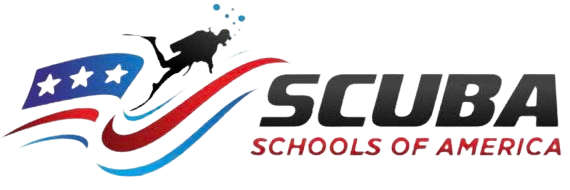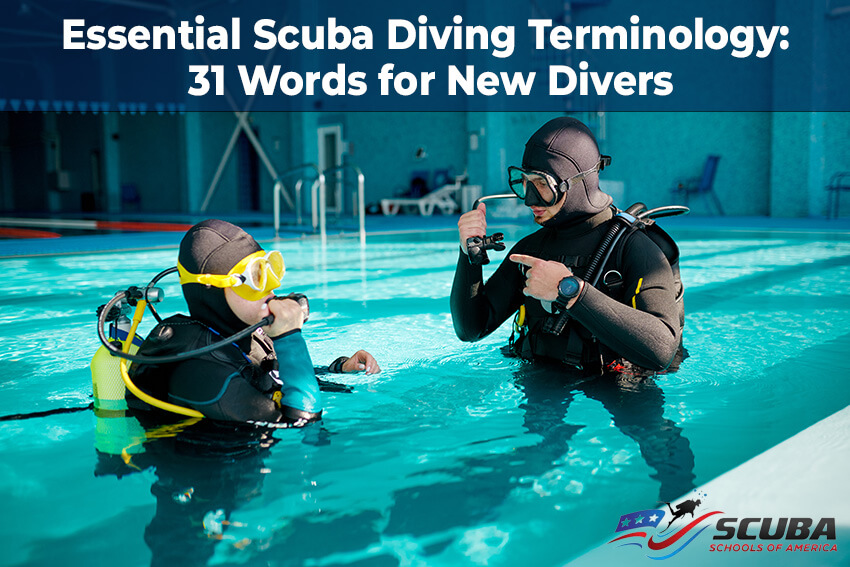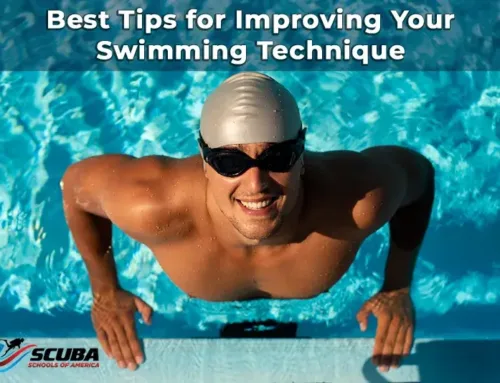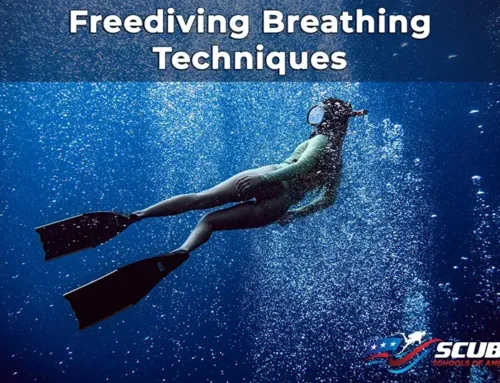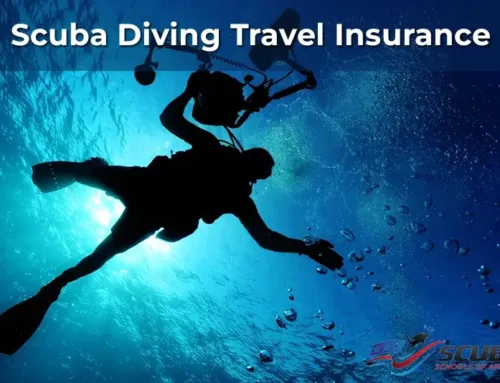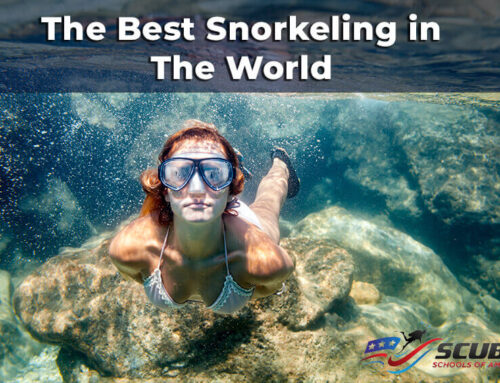Embarking on your journey as a recreational scuba diver introduces you to a unique lexicon that might initially sound like a foreign language. Familiarizing yourself with scuba diving terminology is crucial for navigating conversations with fellow divers.
Here’s a handy cheat sheet to decode what divers are talking about!
Scuba Diving Equipment
Mastering scuba diving terminology begins with knowing the names and functions of your diving gear. Here are key phrases to get you started:
1. BCD/BC/Jacket:
In the world of scuba diving, the buoyancy control device (BCD) is one of the most crucial pieces of equipment. But what exactly is it, and what does it do?
Understanding the Buoyancy Control Device
Most divers simply call it a BCD. This device is essential for managing your buoyancy in the water, allowing you to stay positively buoyant or float on the surface, as well as make precise adjustments during your dive.
BCDs come in various styles, including traditional wrap-around jackets, backplate and wing setups, and small bladders used for side mount equipment, which are popular among cavern and cave divers. Despite the different designs, they all function similarly.
A BCD helps divers relax on the surface, descend to start their dive and return to the surface when they’re done. It also enables them to maintain perfect neutral buoyancy throughout their underwater exploration.
2. Wing:
A Wing buoyancy control device (BCD) features a wing-shaped air bladder located behind the diver’s back. Like the jacket-style BCD, the air bladder of a Wing BCD is typically made from durable, puncture-resistant materials such as nylon or Cordura and can be inflated and deflated using a low-pressure inflator hose.
The wing-shaped air bladder provides lift and stability, allowing divers to fine-tune their buoyancy and maintain a horizontal position underwater.
Wing BCDs are often favored by technical divers or those needing to carry a lot of equipment due to their streamlined profile compared to traditional jacket-style BCDs.
They are also modular in design, allowing divers to attach various components such as tanks, weights, and accessories as needed. Specialized twinset and side mount wings are available, making them popular among tech divers.
Wings also allow for the attachment of multiple weight and trim pockets, potentially eliminating the need for a weight belt, especially since the weight of the backplate adds a few kilos.
This flexibility enables divers to choose where to carry their weight, allowing for precise adjustment of trim and buoyancy control.
3. Regs:
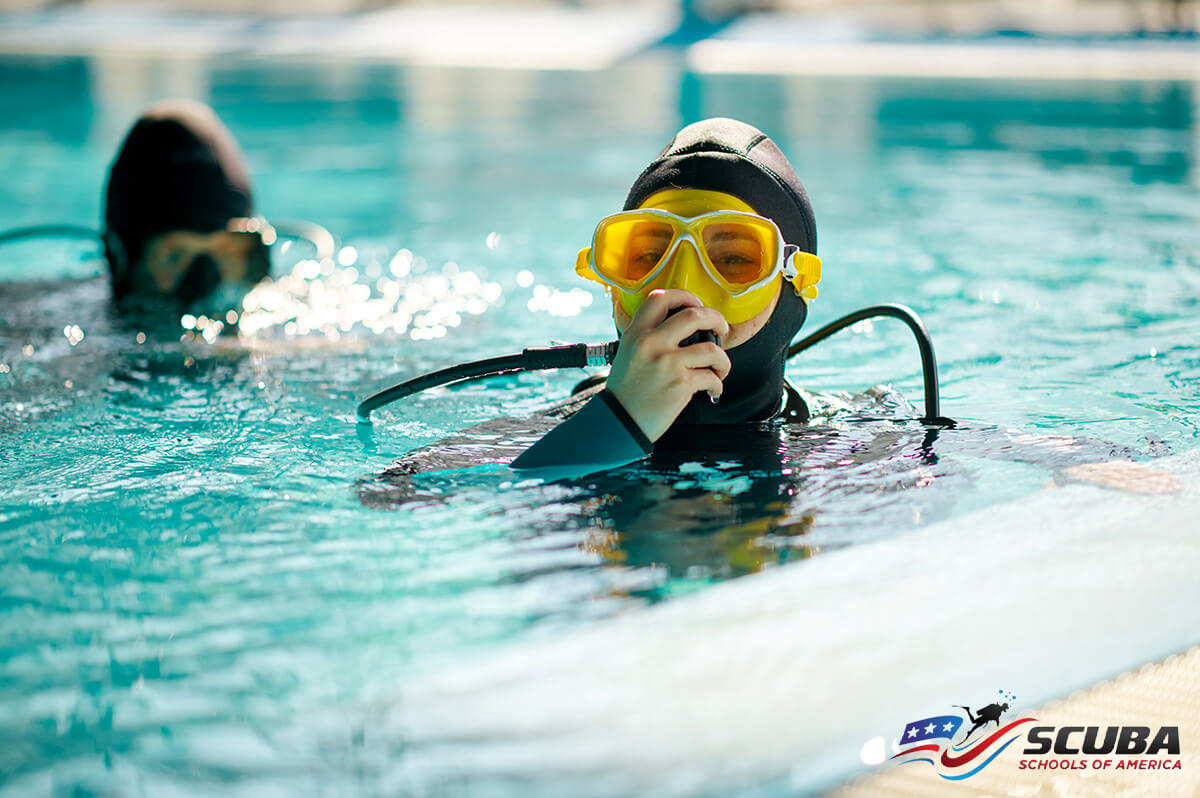
Short for regulators, these control airflow from your tank to your BCD and mouthpiece.
What is a Scuba Regulator?
A scuba regulator is an essential piece of equipment that allows divers to explore the underwater world by enabling them to breathe underwater. It reduces the high-pressure air from your tank to ambient pressure, making it breathable. The regulator also serves as a connection point for several critical pieces of gear.
The best scuba regulators provide smooth airflow, fit comfortably in your mouth, and have a practical hose layout.
4. Diving Octopuses/occy/alternate:
A diving octopus, or secondary demand valve, is a common alternate air source, providing an additional second stage to share air from your scuba tank with a buddy or another diver in need.
The octopus regulator is affordable, convenient, and easy to use. It features a medium-pressure hose that is longer than the primary demand valve hose, allowing more freedom of movement when sharing air.
Technical divers often use hoses as long as 7 feet on their octopuses to swim single file in restricted areas such as caves or wrecks. Additionally, the octopus and its hose are often colored yellow for quick and easy location in emergencies.
5. First stage:
Part of the regulator connecting to the tank, available in ‘DIN’ or ‘yolk’ styles.
How a Scuba Diving Regulator’s First Stage Works
Much like the heart pumps blood throughout the body, the scuba regulator’s first stage serves as the essential link between the diver and the air in their tank, enabling underwater activities.
The primary function of the first stage is to reduce the high pressure from the tank to an intermediate pressure that the second stage can use, delivering air on demand to the diver. Modern first stages are precision-engineered and built to perform reliably under demanding conditions, no matter where divers choose to explore.
6. Inflator hose:
Located on the BCD shoulder, used to inflate or deflate the BCD.
In scuba diving, inflators come in two main types: power inflators and manual inflators. Their purpose is simple: to fill your buoyancy control device (BC) with air.
The power inflator connects to your scuba tank via a low-pressure hose from the regulator’s first stage. Pressing the inflator button releases air into your BC effortlessly.
Alternatively, the manual inflator, also known as the oral inflator, lets you manually inflate the BC by blowing into a mouthpiece on the inflator hose. Simply press a button to open the hose connected to your BC and exhale. This button is typically located near the power inflator button.
On the flip side, deflators and dump valves serve to release air from your BC. By pressing a button on the inflator hose, you can release air using the manual deflator. The easiest method is to orient yourself upright, raise the hose above your head, and depress the deflator button to expel air from your BC.
7. Pressure gauge:
Pressure gauges are critical instruments in scuba diving, used to measure the amount of compressed air remaining in a scuba tank. They provide divers with crucial information about their air supply, enabling them to monitor their breathing gas consumption and plan their dives accordingly.
The variety of pressure gauges available depends on their intended use, with different sizes, types, and materials designed for specific applications.
Pressure gauges are an indispensable part of scuba diving equipment, allowing divers to easily measure pressures underwater. They are classified and represented in various forms, including by use, media, and the process utilized to gauge pressure.
During a dive, a pressure gauge enables the diver to monitor their remaining air supply and estimate how much time they have left before needing to surface. This information is vital for managing dive profiles, decompression obligations, and ensuring a safe dive.
8. Scuba Diving Fins:
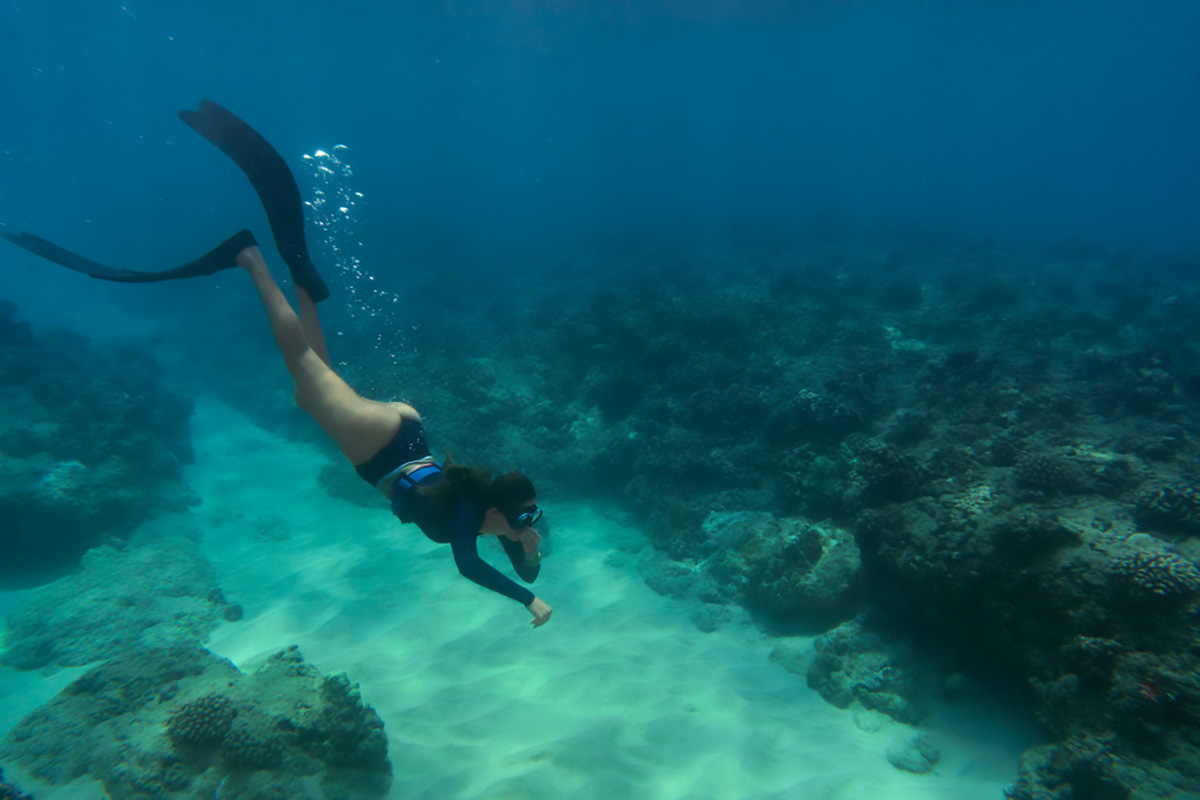
Fins significantly enhance swimming with foot propulsion, making it easier, more efficient, and much more enjoyable.
Scuba divers benefit from fins as they not only propel themselves through the water but also carry their gear. Consequently, fins have been an integral part of scuba equipment from the very beginning.
9. Scuba diving mask:
A diving mask is a crucial component of any diving equipment, essential for comfort and clear vision underwater.
To ensure effectiveness, a diving mask must meet several criteria. It should include a nose pocket for ear equalization, feature tempered glass, have a secure strap, and include a silicone skirt to ensure the mask is water- and airtight.
The comfort of your dive can be greatly influenced by the quality of your scuba diving mask.
Scuba diving masks are available in a variety of sizes and shapes. Finding the right fit is important, and you may need to try on several masks to find the one that suits you best.
10. Scuba tanks/ Bottle:
The diving tank is a crucial component of SCUBA (Self-Contained Underwater Breathing Apparatus) diving. It supplies the high-pressure breathing gas that enables you to breathe underwater.
Additionally, it serves as the storage for your breathing gas, making the diving tank one of the most important pieces of equipment you will bring on your dive.
11. Pony bottle:
A pony bottle, or pony cylinder, is a small diving cylinder equipped with an independent regulator, typically carried by a scuba diver as an auxiliary scuba set.
In emergencies, such as when the diver’s main air supply is depleted, it serves as an alternative air source or bailout bottle, enabling a normal ascent instead of a controlled emergency swimming ascent. The primary feature of a pony bottle is that it provides a completely independent source of breathing gas for the diver.
12. Scuba diving O-rings:
Scuba diving O-rings are small, circular rubber seals extensively used in scuba diving equipment. These O-shaped rings are vital for creating watertight seals between connecting parts, preventing leaks, and ensuring the integrity of equipment underwater.
Diving O-rings are found in various components of scuba diving gear, including regulators, tank valves, dive computers, pressure gauges, and dry suits. Their main function is to maintain a secure and waterproof connection, enhancing the safety and reliability of diving equipment.
Regular inspection, maintenance, and timely replacement of diving O-rings are essential to ensure their effectiveness and the overall performance of scuba diving gear.
13. SMB/Sausage:
An essential piece of equipment for every diver is the “safety sausage,” also known as a surface marker buoy (SMB). Sometimes referred to as a DSMB (delayed or deployable surface marker buoy), its primary function is to aid in locating divers quickly and easily during or after a dive.
The SMB, or safety sausage, can take various forms such as a ring buoy, a large round float, or a diver down flag mounted on a pole and float. These buoys are typically brightly colored—orange, red, pink, or yellow—making it easier for boat crews and fellow divers to spot your position in the water.
14. Rash Guard
A rash guard is a shirt or suit made from materials similar to swimsuits, serving as versatile protective clothing for various water sports. They are available in both long-sleeve and short-sleeve styles.
These types of exposure suits are essential items in any diver’s gear collection.
What Does a Rash Guard Do?
Rash guards are used for various purposes, such as protecting against sunlight, preventing chafing during activities like surfing, and providing thermal protection in cooler waters.
Depending on the material, rash guards may offer benefits like sweat-wicking and quick-drying properties. In some cases, they can even serve as a change of clothes after swimming.
The tight fit helps keep muscles warm by trapping heat against the skin, and the moisture-wicking fabric quickly dries any water on your skin.
15. Logbook:
A logbook, whether a physical book or an online app like MySSI, is where divers track their dives. It includes details such as dive depth, duration (bottom time), and observed marine life.
Even if you’re not a diver but are fascinated by the underwater world, it’s important to know that divers cherish their logbooks and meticulously record each dive as if they were treasures. While not mandatory, maintaining a logbook is highly recommended.
What Is a Diving Logbook and Its Purpose?
A diving logbook is a record of dives, documenting key information for each dive.
Typically, the first entry in a diving logbook is made during your Open Water course. These records are authenticated by your instructor, who also teaches you how to properly use the logbook. After completing the course, your “dive buddy” verifies the entries with their signature.
16. Nitrox:
Nitrox refers to a gas mixture in the tank that differs from standard air, which contains 21% oxygen and 79% nitrogen. It has a higher percentage of oxygen, allowing divers to have longer bottom times without needing to ascend as quickly. You can become a Nitrox diver by completing an enriched air Nitrox certification. These certifications are very popular and enable divers to maximize their dive experiences.
Diving Procedures and Safety
Your safety is paramount, and you’ll learn all about staying safe in the water during your scuba diving courses.
Our skilled instructors are committed to creating a safe and enjoyable learning atmosphere where students of every skill level can flourish. Prepare to dive in, create waves, and embark on an exhilarating aquatic journey with us at Scuba Schools of America!
To get you started, here is some essential scuba diving terminology:
17. Getting Bent/DCS:
Decompression sickness (DCS) is a medical condition that can occur from surfacing too quickly or staying too deep for too long. It is sometimes referred to as “getting bent” because it can cause pain in the body’s joints, making the diver bend or hunch over in pain.
18. Bottom Time:
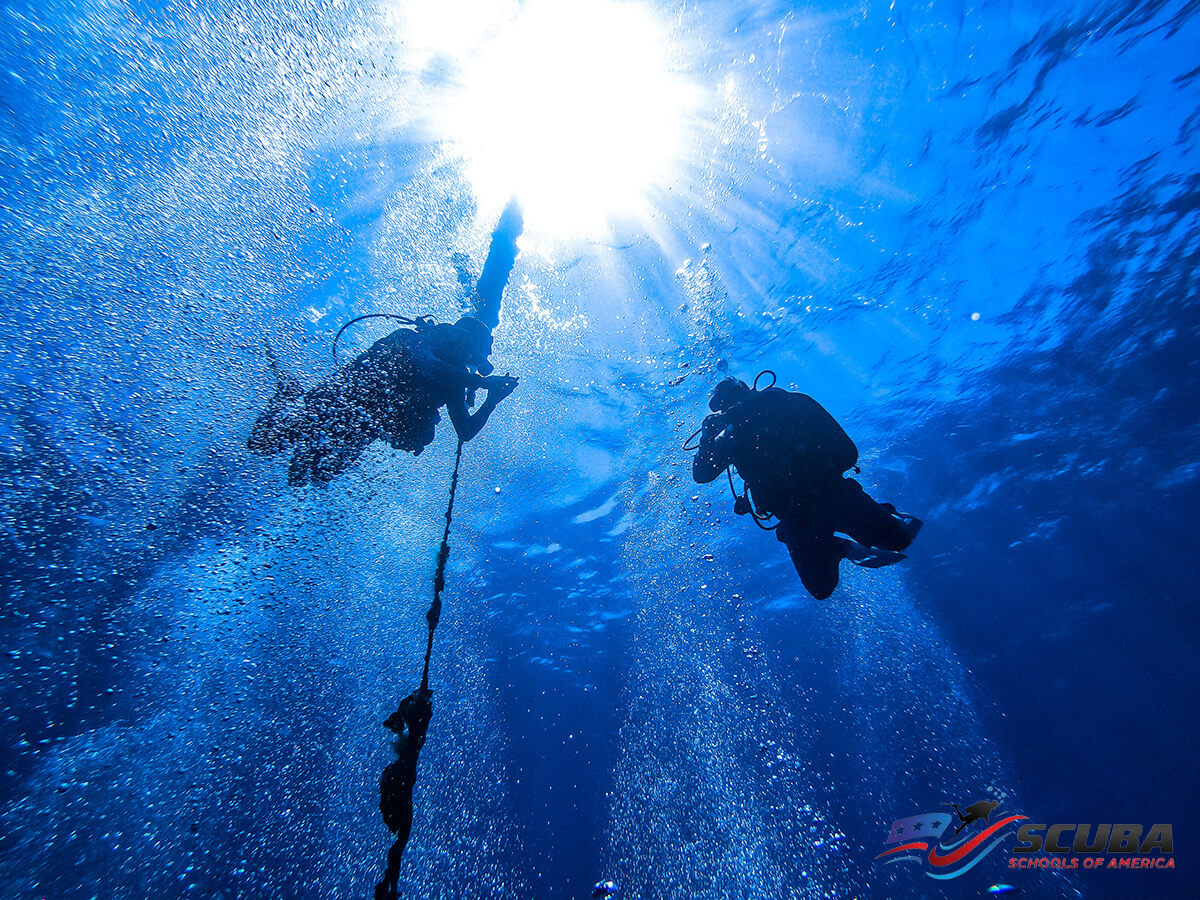
Bottom time starts when a diver descends below the water’s surface and ends when they begin their ascent back to the surface. It excludes the time spent on the ascent itself or during decompression stops required to safely dissolve gas bubbles from the body.
The primary reason for tracking bottom time is to calculate decompression obligations and avoid decompression sickness (DCS), a potentially life-threatening condition.
19. Deco:
In most recreational diving, you should not experience deco dives. A deco dive occurs when a diver exceeds the no-decompression limits, necessitating a longer or additional safety stop on the way to the surface due to staying too deep for too long. While this is planned for in deep technical diving, it is avoided in recreational diving.
20. Off-Gassing:
During a dive, our bodies absorb nitrogen. Nitrogen bubbles can form in the body’s tissues and cause DCS if our body does not properly off-gas the extra nitrogen, which can happen due to a rapid ascent or exceeding diving limits.
21. Surface Interval:
A surface interval is the time a diver spends on the surface between dives. During this period, the excess nitrogen that dissolved into the body during the previous dive begins to dissolve back out. The length of the surface interval depends on the depth and duration of the previous dive and the dive plan for the next dive, ranging from a short break to several hours.
22. Safety Stop:
At the end of a recreational dive, a safety stop is made to off-gas nitrogen while still at a shallow depth, speeding up the process compared to being on the surface. A standard safety stop lasts for three minutes at a depth of around 5 meters (16 feet).
23. No-Fly Time:
The standard guidelines for flying after diving are to wait 12 hours after a single dive and 18 hours after two or more dives. Some divers prefer to wait 24 hours to be sure. Flying after diving can be dangerous as it increases the risk of DCS.
Scuba Diving Skills
Whether you’re a novice scuba diver, an Advanced Open Water diver, or an experienced tec diver, mastering various dive skills is essential. Here’s the scuba diving terminology you’ll encounter as you refine your abilities:
24. Backroll:
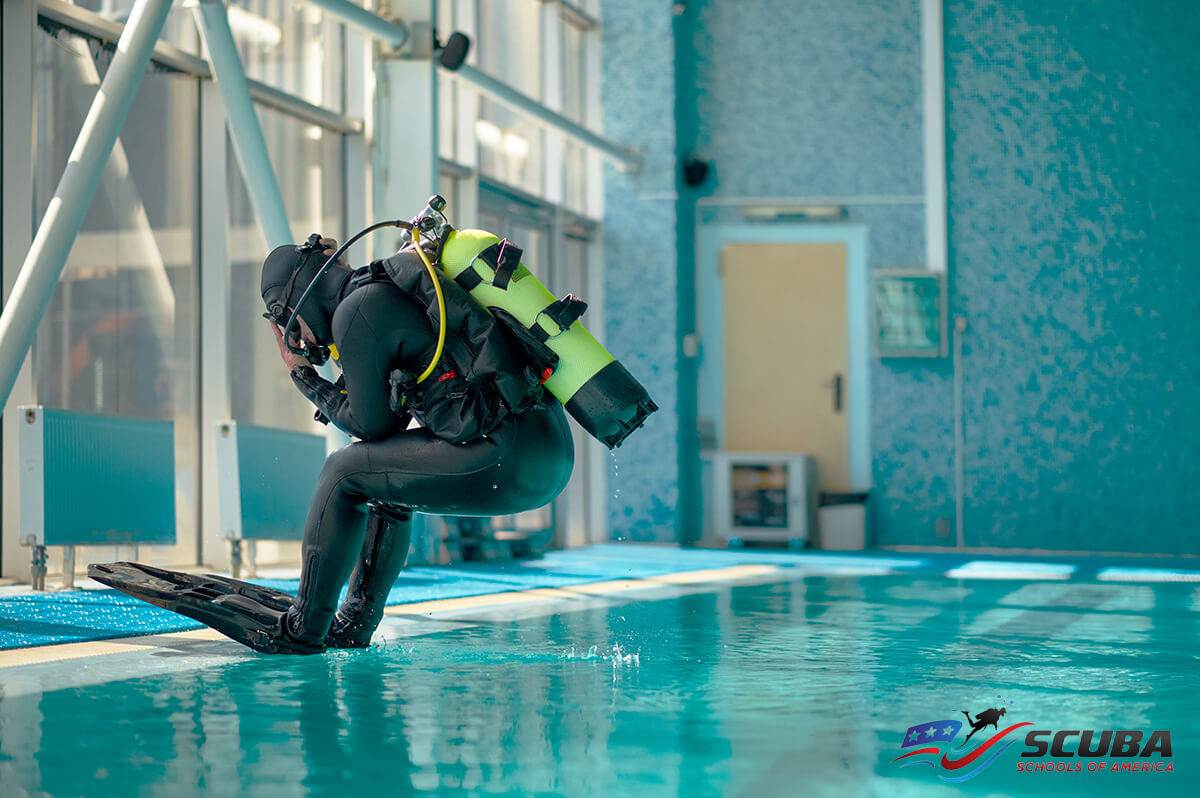
This technique involves entering the water from a small boat. The diver rolls backward into the water, typically following instructions given during dive briefings by your SSI Dive Guide.
25. Giant Stride:
Another method of entering the water, often from a boat or a ledge, where the diver steps forward from a standing position.
26. Buoyancy:
This refers to your position in the water while diving. Being ‘neutrally buoyant’ means you neither float upwards (positively buoyant) nor sink downwards (negatively buoyant). Buoyancy control involves using your breath, buoyancy control device (BCD), and weight belt.
27. Hover:
Hovering occurs when you maintain neutral buoyancy without using your fins to move. It’s useful for observing marine life or maintaining position, such as encountering a manta ray.
28. Dive Trim:
Trim in scuba diving refers to your orientation and balance underwater. It involves maintaining a stable position relative to your direction of movement (ascending, descending, or horizontal). Proper trim reduces effort, conserves air, prevents contact with the seafloor, and improves visibility.
Achieving good trim requires correct weight distribution, effective equipment use, and controlled breathing. It’s crucial for both novice and advanced divers, enhancing the diving experience while minimizing environmental impact.
29. Dive Buddy:
Your dive buddy is your safety partner during dives, and vice versa. It’s essential to stay close and regularly check on each other’s well-being. Building friendships with dive buddies is one of the joys of scuba diving worldwide.
30. Equalize:
Equalizing involves adjusting the pressure in air spaces of your body, such as ears and sinuses, as you descend. Techniques include pinching your nose and blowing gently or adding air to your mask to counter pressure.
Mastering equalization is fundamental for all divers, ensuring comfort and safety during descents and dives.
31. Liveaboard:
A liveaboard is a multi-day diving trip where participants stay aboard a boat, accessing multiple dive sites. This format is popular for exploring remote and renowned dive destinations like the Socorro Islands, Galapagos Islands, and Palau.
Explore the Underwater World with Scuba Schools of America in Montclair
Dive into adventure and discover the beauty of the underwater world with Scuba Schools of America! Whether you’re a beginner looking to get certified or an experienced diver seeking new challenges, our expert instructors and top-notch facilities in Montclair are here to help you achieve your diving dreams.
To find out more, feel free to give our office a phone call or send us an email using the contact form on our website.
